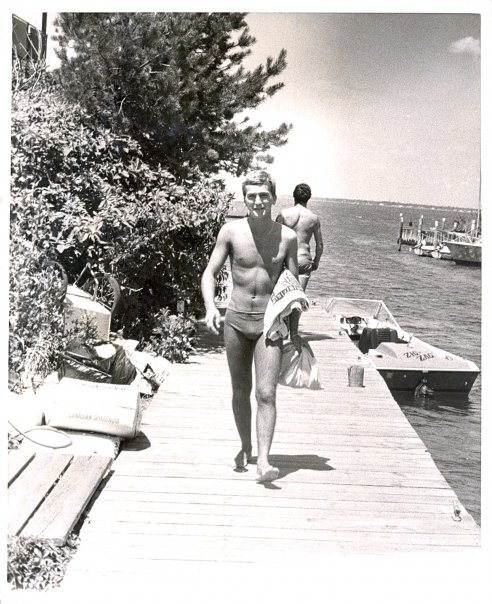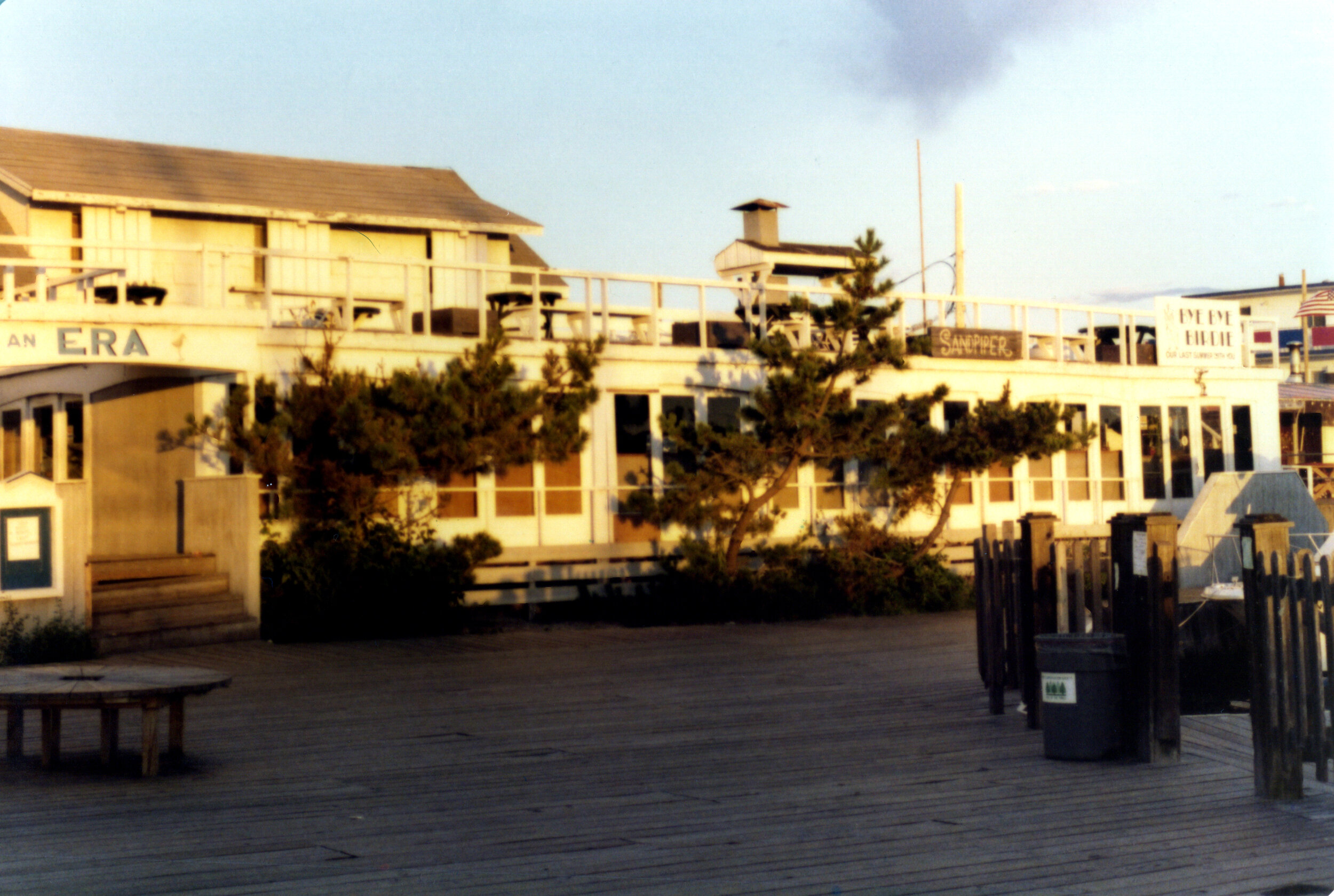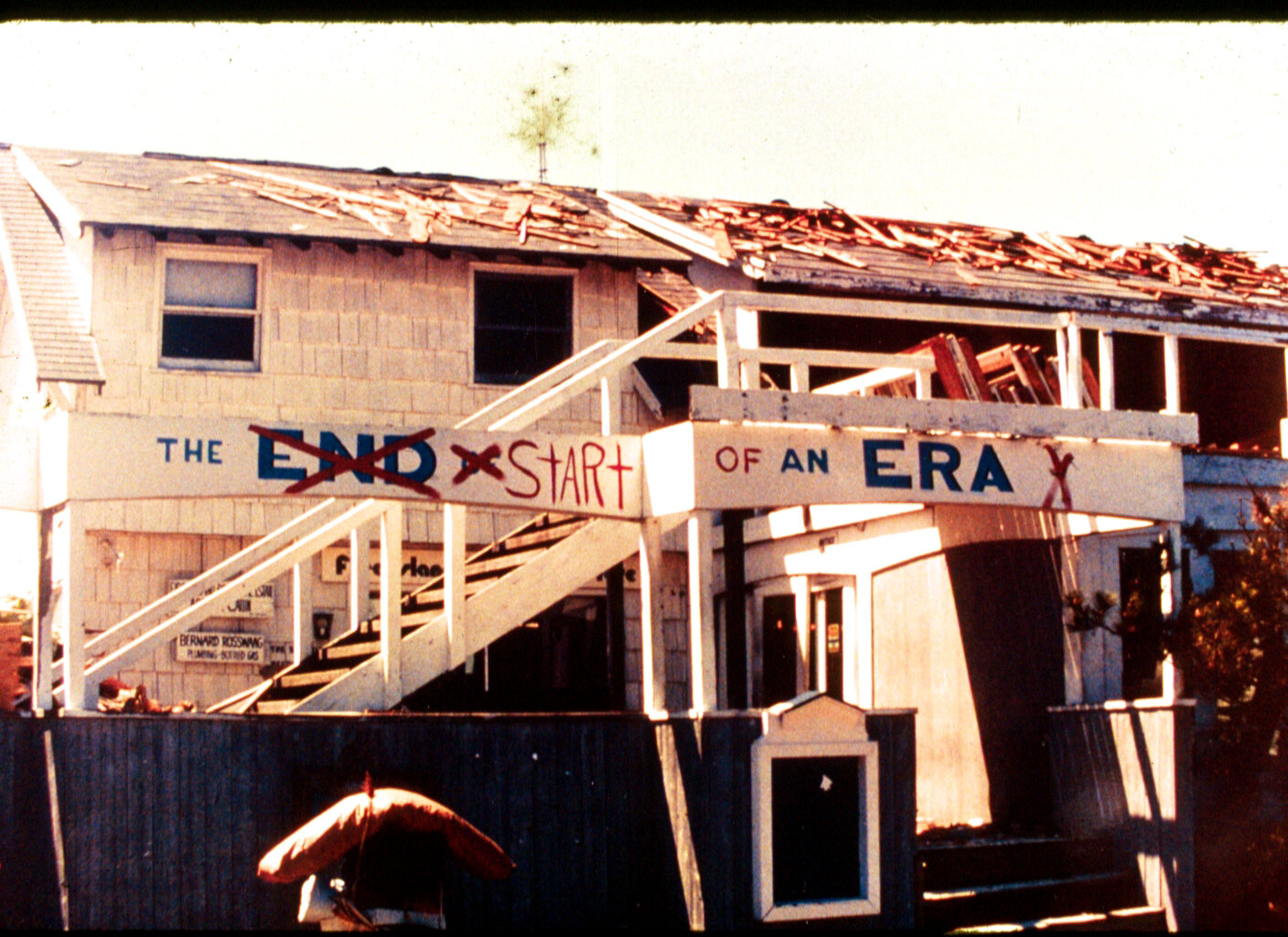The Sandpiper Est.1965-1979
1965. Model behaviour…
The cornerstone of the Pines was originally the site of a model home, then the office of Realtor Arden Catlin and the Post Office. The building was owned by Arden Catlin. The building would take on many roles before it found its namesake.
Photo: Getty Images Marvin Lichtner.
Who was Arden Catlin?
Arden Catlin was the first Postmistress of the Pines, and an original pioneer of the Pines so it was natural for The Home Guardian Company Of New York owners of the land to ask her to be one of the first realtors.
With partners Cappy Hanlan and Myra she also opened the Picketty Ruff Cafe. It was a homespun café that catered to the local clientele including an ice cream stand for children.
1966. A new chapter begins…
In 1966 Gene Smith and then partner Ron Malcolm with other partners made her an offer she could not refuse and opened the Sandpiper restaurant. To accommodate the plan additions to the building were planned and executed.
1965-66. Advertising begins…
As the Pines swung into the 60’s so did the clientele. Soul music was the sound, and the new Sandpiper was about to create competition for the Blue Whale jukebox. Which was the only game in town …
1965. The restaurant was designed with the community in mind with a sophisticated beach esthetic it became frequented by many from all parts of Fire Island.
The Restaurant:
Chef Ernesto Tenente from Cherry Grove made the move to the Sandpiper as chef. Having arrived in the Grove in 1947 on the invite of a friend from New York he fell in love with the place, and managed to stay by working as a chef in Pat Stephani’s newly opened restaurant where he cooked, but also entertained customers with operatic renditions. He would move onto the Tiffany Room with owner Jimmy Merry as the Grove evolved. As the Pines grew he saw opportunity. He made a name for himself. After a conflict at the Sandpiper he later would move onto the Blue Whale as chef.
1967. The Sandpiper became the cornerstone of the community, and the perfect viewing point for events like the annual Dog Show seen below.
1970. The age of Disco begins…
With the advent of Disco the Sandpiper transforms after dinner as chairs are moved away for late night dancing.
DJ Robbie Leslie remembers:
DJ Robbie Leslie remembers…
“The Sandpiper was a low one-story building as far as public spaces. And it was all open in the front, which was great, because they could open all the windows, there were like five glass doors and they could open the entire front of the façade and let the wonderful summer breezes come in off the harbor. It was a restaurant in the early evening.
It was kind of divided in half by a row of banquettes and the other side was the dining room area and that had removable tables and director’s chairs.
Everything was a blue and white theme. On the inland side, not the harbor side, that was the dancefloor, again it was one-story and it was not a high ceiling. If you were tall you could touch the beams. It had a very rudimentary light show. They had those little small twinkly Christmas lights. They were stapled up to the cross beams where they would chase up and down and it actually created a remarkable effect because all the walls on that side were mirrored and they had blue Plexiglas columns against the far wall which had those little twinkle lights inside them as well and they would chase back and forth and with the mirrors it would look like an infinitely long trompe l’oeil effect.
It was actually quite impressive. Everything was wood out there so the dancefloor was bare wood; it was very comfortable for all night dancing. And back then, strictly speaking, we weren’t an after hours place so we would close at 4am. The crowd danced inside. There was an inside deck, but that was mostly just to go out and have a cigarette and have a drink and cruise. The dancefloor and the speakers were just inside. the capacity was between 5-600 on the weekends and then it would be 300 on weeknights during the season.”
Everyone went to Cherry Grove on Saturday nights, it was all about the Ice Palace. Roy Thode (below) was the head DJ there. So the Sandpiper and the Pines was deserted on Saturday nights. It was one of the earliest clubs to have a Graebar Sound System.
After meeting Sandpiper owner Gene Smith in Florida a young Robbie Leslie begins his F.I. journey with his job waiting tables at the Sandpiper. It is here he watches and learns the art of the DJ. Owner Gene Smith lets him begin playing during the week. He started off season and this was the time when normally they would play reel-to-reel tapes, which they would record over the summer when other DJs would play. So after Labor Day they would just play these tapes, so they didn’t feel like they were gambling by having him play. Because normally there wouldn’t have been anyone else…
The upper deck floor housed some of the employees. Every community has its eccentrics, and so it was David Campbell to the Pines. David (seen below and here with Robbie Leslie) would dress up and play his tambourine at Tea Dance and at the Sandpiper. He played backround on several Disco records of that period.”
DJ Robbie Leslie
More memories…
“I worked at the Sandpiper from 1975 until its closing on Halloween 1979 – in fact, I was the DJ for the closing party, called “LAST DANCE”. Though I began as a waiter, I began spinning late in 1977. I remained a weeknight DJ until the closing and then moved to NYC and 12 West, The saint, Underground, Palladium, etc.
A few minor points: The Sandpiper was owned by Arden Catlin and leased for 15 years by co-owners Smith & Malcolm. The lease expired after the 1979 season. Initially it was a very successful restaurant, but morphed into a restaurant/disco in the early seventies.
Dinner business dropped off drastically in later years, as Fire Islanders began to eat by and large at home. The Lemon Tree, a Cherry Grove restaurant, leased the restaurant concession in later years.
Michael co-owner of the Lemon Tree restaurant 1977.
We had one of the first setups built by Graebar Sound. They were the company that later did the Saint, 12 West, Trocadero Transfer, Dreamland and Salvation. We had two Technics turntables with a Bozak mixer and an actual light show-a true DJ booth. The booth was on the dance floor against the back wall. The system was tonally balanced which gave it a very smooth sound and it never was harsh or fatiguing even at high volumes.” With the growth of the Disco sound the Sandpiper focus shifted with an emphasis on the disco. Friends became family. David Van Brundt and Bob Jory below.”
1976 The Bicentennial.
The relationship that the Sandpipers owners had with the community was a good one, however as the sound of Disco got louder and emphasis moved to more nightclub than restaurant the community responded. The battle of music began…
Many in the community who enjoyed the music and dancing would stage their own parade walking in unison through the co op’s singing the disco hit of the time “Don’t take away the music.”
It was here in that mega producer Tom Moulton created the long playing disco mix. He would go on to producing Gloria Gaynor’s classic disco album “Never can say Goodbye” with its first ever continuous mix side.
Sandpiper in art…(R)Artwork by Michael Murphy, and sold at Melbamar. (Below) John Laub.
As the 1970’s came to a close so did the era of the Sandpiper. The property has become valuable and the lease with Arden Catlin and the now lone partner Gene Smith was expiring. Offers from other club owners were coming in, and it would go to the highest bidder. Gene had made a great deal with Arden that at the time worked for both, but as the club became popular the value increased making it now time to pay the piper. In the end Gene decided to close, but not without a bang…
Before the doors were closed for the last time there would be a “Last Dance.” A party held on Halloween weekend to celebrate the Sandpiper and the end of and era.
DJ Robbie Leslie would DJ the all night event.
A night that would go down in Pines history.
By Brian Chin. Brian Chin reported on dance music for Record World and Billboard from 1978 to 1987. Currently, he consults in A&R for Atlantic Records, and has produced and/or co-annotated dance and R&B reissues for every major label, including Rhino’s The Disco Box, Universal/Motown’s The Supremes Box and Diana Ross & the Supremes No. 1’s, and Sony/Legacy’s The Philly Sound .
IN YOUR HANDS is a celebration, a landmark and an elegy: with this set of music, Robbie Leslie closed Fire Island Pines’ legendary Sandpiper, on the night of October 27, 1979. From its 1965 opening, the Sandpiper had morphed from a restaurant with a jukebox, to a focal point of Fire Island gay culture. Over that span of time, men who, at the outset, couldn’t even be seen dancing together, formed a movement that transformed the cultural, social and political face of our world.
Here, the vast richness of our music is evident, and so is the concept of the DJ as a collaborative artist — with the musicians and singers, on one hand, and with the crowd, on the other. That latter aesthetic is manifest not just in this singular DJ performance, but, equally and inescapably, in the tangible spirit and the lasting influence of all the men who played the live and taped evenings of music at the Sandpiper, through the building and eventual boom years of disco: Tom Moulton, Ray Yeates, Tom Savarese, Larry Sanders, Alan Dodd, Howard Merritt, Richie Rivera, and Barry Lederer, among them.
It’s well known that two summers of waiting tables turned into three seasons of DJ-ing for Robbie at the Sandpiper — his first DJ job there, in fact, was making tapes in the post-Labor-Day lull. For the closing night, with the Island normally deserted in late October, a roomful of partiers was bussed and ferried out from Manhattan. It turned out to be a personal and professional milestone for Robbie, who planned the night as a celebration and an occasion for joyful memories, in tribute to the years that the club was the major gathering place in Fire Island Pines’ community.
The club was not decorated for the event, so that it appeared exactly as everyone remembered it, and the kitchen served a special breakfast after sunrise. Robbie distinctly recalls that the night went by in a flash, with a combination of stress, electricity and warm family spirit. With the arrival of the partygoers, the dance floor went from empty to packed “in about sixty seconds,” and it remained so for the entire night.
Robbie’s music was devised for maximum impact from the first song till the last, for a group of men who’d made a special trip to be in a special place for one last time. “It was a very ‘up’ party,” Robbie says: “The thrust of the music was towards that major-key, positive, high energy fare that we now call anthems. The bursts of energy that would greet some of the great hits like ‘Relight My Fire,’ ‘Enough Is Enough,’ Brainstorm, The Raes, and especially, ‘Last Dance,’ were quite thrilling.”
Ever had a long, lingering, unforgettable last kiss? Or, maybe, an encounter that you knew would be your last — and it was someone you’d shared a lot of history with? That’s what happened here, on a tribal level. Life went on, and needless to say, changed in many ways. The summer of ’79 had introduced Robbie to what he calls “the gay cognoscenti,” and playing this major event affirmed his arrival into the big leagues, paving the way for a move into Manhattan and his first job in New York, at 12 West.
Whenever I look back on this era of clubbing, I’m reminded of how much we used to demand of our music — and consequently, how long we’ve been able to continue to live with it, on and off the dance floor. There’s an awful lot of music here: drama, fun, heartbreak, happy endings. That’s a tribute, of course, to the great writers and producers and performers of R&B, pop and disco.
I’m also reminded that the DJs we went to for that special shared experience were notably not only because they popularized a long list of songs and artists, but because they used their feel for the musical and emotional content of music, literally hands-on, to elicit and orchestrate, and routinely, actually resolve the feelings of a whole crowd of people.
Like minister in a pulpit, the club DJ is still invoking the spirit and leading a ritual. Much as the Bible and the hymnal are animated by the preacher, and shared with the people, the music is brought out, in context, to a motivated congregation in nights like this one, and its deeper meanings — its many connections to our real lives — become obvious.
1980. A new building was about to arrive. Along with a new era in Pines history. It would be called the Pavilion , and like the Sandpiper there would be multiple owners.
Flash forward 27 years later…
In 2006 New commercial district owner Eric Von Kuersteiner demolished the Pavilion built in 1980 to make way for a new Pavilion. Underneath the Pavilion structure was the Sandpiper that they had built right over. History unfolded as all came back to the many longtime residents who had many memories there. Some even came to take a piece of history.












































